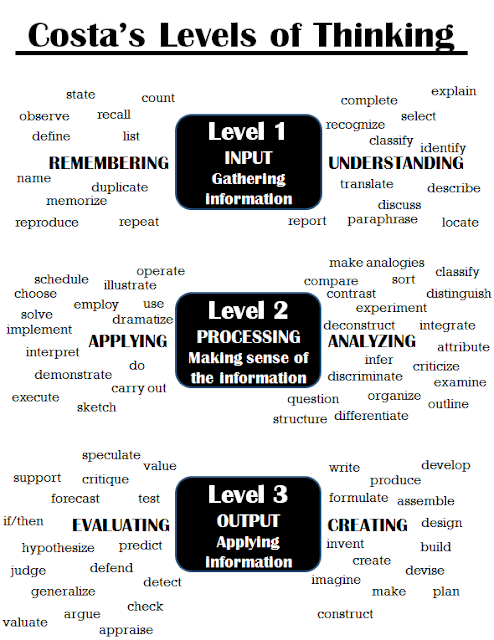For years I've used
Costa’s Levels of Thinking in my AVID, English, and Humanities classrooms to
help my students push themselves to higher levels of cognition and to assist
them in analyzing their own thinking on assignments and assessments. When going
over the results a test, I've asked students to identify the levels of thinking
required by the questions that have posed a challenge for them. Knowing what
kind of thinking is tripping them up has allowed them to refine their study
skills for continued growth. We've written questions together and dissected the questions of others. Costa’s Levels of Thinking have made a world of difference
in the way my students learn.
Recently, I had an
epiphany. Not only can Costa’s increase student success, but improvement-minded
teachers can use Costa’s to shape and guide their own instructional efforts.
Costa’s Level 1 refers
to the information-gathering stage of thinking. This is the realm of right and
wrong answers. Level 1 thinkers simply need to know facts and ideas that others
thought of first. Level 1 knowledge is essential for every teacher. Not only must
teachers know the nuts and bolts of their subject matter, but they also must
understand the state’s essential elements or standards, the district’s
curriculum (if such a thing exists), and the rules and policies of the school. Spending time studying
lessons on the curriculum database, reading instructional materials, boning up
on content, discussing curriculum maps, familiarizing yourself with the
textbook, and perusing the TEKS involves necessary Level 1 thinking. Teachers
should also be aware of student data: What are the specific strengths and
weaknesses of my students, as a class and as individuals?
Effective teachers can’t
stop with Level 1 knowledge, though. Level 2 thinking--the kind where you do
something with the Level 1 knowledge by applying and analyzing what you know--must
take place so teachers can bring instruction to life.
Level 2 thinking for
teachers involves customizing the curriculum and standards for their individual
campus situations. Teachers consider the needs of their students to determine
what instruction needs to look like. Classrooms with multiple ability levels or
multiple levels of understanding suggest opportunities for differentiation. In
other words, the Level 2 thinking forces teachers to consider how to most
effectively implement instruction. It also requires teachers to connect the
dots between the elements so that instruction is seamless and has a
recognizable direction. Level 2 is the problem-solving stage. It’s all about
putting what you know into action.
More importantly, Level
2 thinking also requires teachers to ask themselves, “Why?” Why am I
teaching this content? Why is this skill necessary for my students to learn?
Why is the curriculum written the way it is? What is the thinking
behind this curriculum document? When a teacher can articulate the “why”
behind the subject matter and curriculum, students will understand the “so
what” for the things they’re asked to do.
Level 3 thinking occurs
during and after the lessons are taught. Teachers view their instruction
through an evaluative lens. What went well? What didn’t? Why? What do I need
to do differently next time? Did my students perform to expectation? If not,
how will I need to adjust to remediate or reteach? Often, I find that
as teachers we rush from one activity or assessment to the next and don’t allow
ample time for reflection and growth. Level 3 of Costa’s reminds us of the
importance of evaluation; it’s how we get better at what we do. The best
teachers--like great athletes--are always self-assessing and making
microadjustments as they teach, sometimes even in the middle of lessons.
Sometimes, teaching also
provides the satisfying Level 3 task of creating. Teachers--individually or on
campus or district curriculum teams--take everything they know about learning,
content, standards, and students and synthesize all that knowledge to produce
thoughtful curriculum units and lessons to engage students and meet their
needs. It’s a monumental task that requires the teacher to be simultaneously
detailed and visionary.
I encourage my teacher
friends to join me in some metacognition about Costa’s and their own journeys
in education. Take stock of the thinking you’re doing and consider what you can
do to strengthen any areas of weakness. Let Costa’s Levels of Thinking guide
you toward continual improvement. It’s what we’d expect from our students, so I
think it’s worth expecting of ourselves.

This comment has been removed by the author.
ReplyDelete